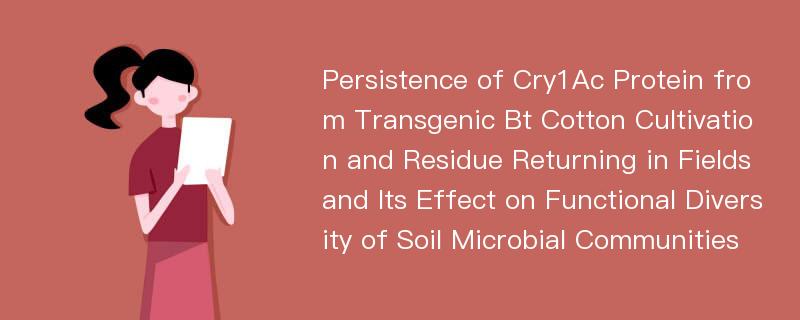
论文摘要
The persistence of Cry1 Ac protein in the soil and its effect on soil microbial communities are a core issue in assessing the ecological risk of transgenic Bacillus thuringiensis(Bt) cotton. In this study a field experiment was conducted on the cultivation of transgenic Bt cotton(Jin 26 and BtJ i 668) with the immediate returning of residues to the fields, in order to quantify the Cry1 Ac protein content in the fields and investigate its effects on the functional diversity of soil microbial communities. Cry1 Ac protein in the residue-soil mixture was gradually degraded in the transgenic Bt cotton fields. After transgenic Bt cotton straw was returned to the fields for 30 d, 63.73%and 58.33% of the initial amounts of Cry1 Ac protein were degraded in the Jin 26 and BtJ i 668 fields, respectively. Before the crops were sown in the following year(180 d after returning the straw), no Cry1 Ac protein was detected in the fields. After returning the cotton straw to the fields for 30 d, the Shannon-Wiener and McIntosh indices of soil microbial communities in the transgenic Bt cotton fields were significantly higher than those in the non-transgenic cotton fields. Meanwhile, the utilization of carbon sources including amino acids, amines, and carbohydrates by the soil microbial communities significantly increased. Both the McIntosh index and the utilization of carbohydrates increased until 180 d. Principal component analysis revealed that amino acids, amides, and carbohydrates were the main carbon sources distinguishing the two principal component factors. These findings indicated that Cry1 Ac protein did not accumulate in the fields after transgenic Bt cotton was planted for one year and the residues were immediately returned to the fields; however, the original functional diversity of soil microbial communities was affected continuously.
论文目录
文章来源
类型: 期刊论文
作者: ZHANG Meijun,FENG Meichen,XIAO Lujie,SONG Xiaoyan,Guangwei DING,YANG Wude
来源: Pedosphere 2019年01期
年度: 2019
分类: 农业科技,基础科学
专业: 生物学,农业基础科学,农艺学
单位: College of Agriculture, Shanxi Agricultural University,Department of Chemistry, Northern State University
基金: supported by the Shanxi Provincial Natural Science Foundation of China (No. 2012011030-2),181 Cultivate Foundation of National Natural Science from Shanxi Agricultural University (No. 2017GPY07)
分类号: S154.3
页码: 114-122
总页数: 9
文件大小: 215K
下载量: 41
相关论文文献
- [1].High-throughput phenotyping in cotton:a review[J]. Journal of Cotton Research 2019(03)
- [2].Soil replacement combined with subsoiling improves cotton yields[J]. Journal of Cotton Research 2019(04)
- [3].Journal of Cotton Research Contents of Vol.2(2019)[J]. Journal of Cotton Research 2019(04)
- [4].Survey on the work resumption of 4,650 enterprises in 19 clusters of cotton textile enterprises[J]. China Textile 2020(02)
- [5].Moisture-sensitive torsional cotton artificial muscle and textile[J]. Chinese Physics B 2020(04)
- [6].Analysis on Content and Distribution of Residual Film in Fields of Different Crops[J]. Meteorological and Environmental Research 2020(03)
- [7].Egypt's long-staple cotton exports break new lows[J]. China Textile 2020(Z1)
- [8].Patterns of presence-absence variants in Upland cotton[J]. Science China(Life Sciences) 2020(10)
- [9].Heritability and correlation analysis of morphological and yield traits in genetically modified cotton[J]. Journal of Cotton Research 2020(03)
- [10].Development and application of perfect SSR markers in cotton[J]. Journal of Cotton Research 2020(03)
- [11].A genome-wide identification of the BLH gene family reveals BLH1 involved in cotton fiber development[J]. Journal of Cotton Research 2020(03)
- [12].The impact of plant density and spatial arrangement on light interception on cotton crop and seed cotton yield:an overview[J]. Journal of Cotton Research 2020(03)
- [13].Cotton Incorporated FW21/22 Trendforecast[J]. China Textile 2020(05)
- [14].National cotton organizations voices their appeals to the industry to cope with the crisis[J]. China Textile 2020(05)
- [15].Efficiency of cotton bollworm (Helicoverpa armigera Hübner) control of different Bt cotton varieties in North China[J]. Journal of Cotton Research 2018(01)
- [16].Forecast and prospect of new cotton in Xinjiang in 2019/2020[J]. China Textile 2019(10)
- [17].Spatial distribution of bolls affects yield formation in different genotypes of Bt cotton varieties[J]. Journal of Integrative Agriculture 2019(11)
- [18].Cotton Incorporated's professional curriculum expands with focus on technical textiles[J]. China Textile 2018(01)
- [19].View of cotton from supply:What's the largest variation in 2018?[J]. China Textile 2018(04)
- [20].Increased lateral root formation by CRISPR/Cas9-mediated editing of arginase genes in cotton[J]. Science China(Life Sciences) 2017(05)
- [21].Developmental and hormonal regulation of fiber quality in two natural-colored cotton cultivars[J]. Journal of Integrative Agriculture 2017(08)
- [22].Overexpression of GhFIM2 propels cotton fiber development by enhancing actin bundle formation[J]. Journal of Integrative Plant Biology 2017(08)
- [23].Susceptible time window and endurable duration of cotton fiber development to high temperature stress[J]. Journal of Integrative Agriculture 2017(09)
- [24].Cotton Incorporated: SS17 Trend Forecast[J]. China Textile 2015(12)
- [25].Impact of temperature on yield and related traits in cotton genotypes[J]. Journal of Integrative Agriculture 2016(03)
- [26].Moving Toward Sustainability in the Cotton Supply Chain[J]. China Textile 2016(05)
- [27].Cotton Incorporated 2017/18 A/W Trends[J]. China Textile 2016(06)
- [28].High-throughput sequencing-based genome-wide identification of micro RNAs expressed in developing cotton seeds[J]. Science China(Life Sciences) 2015(08)
- [29].Snow Is Falling[J]. 阅读 2019(Z4)
- [30].Direct Subsidies for cotton grower is expected to be implemented[J]. 纺织服装周刊 2013(21)
